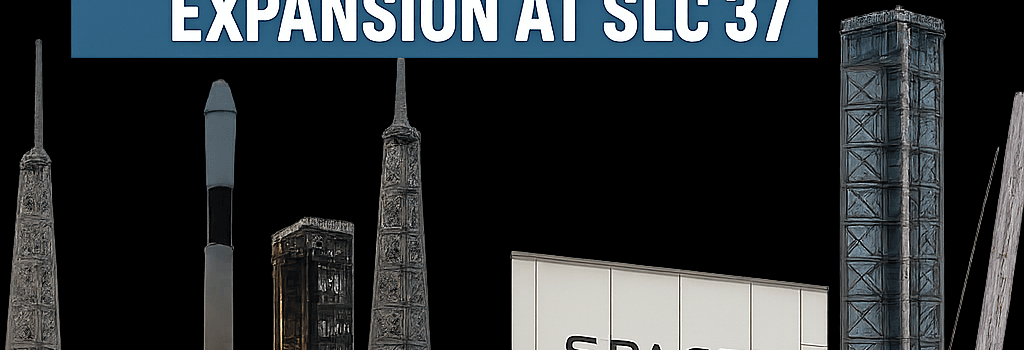Rocket Report: Themis Delays and SpaceX Expansion at SLC-37

Summary
Edition 7.48 brings updates on Europe’s reusable Themis booster slipping to 2026, Canada’s Reaction Dynamics securing launch funding, SpaceX’s move into SLC-37 for Starship operations, and more. We delve into the technical details, programmatic challenges, and what these developments mean for the commercial launch market.
Canada Invests in Domestic Small-Sat Launch
Investment: Quebec has pledged CA$10 million (US $7.3 million) to Reaction Dynamics, based in Longueuil, Quebec. The funds support final assembly and launch pad construction for the Aurora orbital launcher, targeting first payload deployment by 2027.
Technical Deep Dive: Aurora Propulsion and Flight Profile
- Propulsion: Dual-core liquid oxygen (LOX)/kerosene engines, each producing 80 kN of thrust at sea level and 90 kN in vacuum. Specific impulse (Isp) is 330 s in vacuum.
- Stage Mass: First stage dry mass of 4 tonnes, propellant load of 15 tonnes. Second stage carries 5 tonnes propellant.
- Flight Profile: Vertical takeoff, MECO at T+150 s, stage separation at 50 km, second-stage circularization burn at T+600 s.
“With this injection of capital, Reaction Dynamics can complete Transport Canada’s licensing process and begin static-fire tests at Canso Spaceport in Nova Scotia by mid-2025,” says aerospace analyst Dr. Marie Fortin.
Themis Reusable Booster Demonstrator Delayed to 2026
The European Space Agency’s (ESA) Themis program, led by ArianeGroup, has slipped its first vertical hop from late 2025 to mid-2026. The demonstrator—analogous to SpaceX’s 2012 Grasshopper—will validate reusable booster technologies for the future Ariane-scale launcher.
Engine Specifications and Test Stand Upgrades
- Methane-Fueled Prometheus Derivative: Single-engine variant thrusting 100 tonnes, Isp of 360 s in vacuum.
- Test Stand Vernon Phase II: Upgraded to 120 bar chamber pressure, expanded data-acquisition bandwidth (10 kHz) for high-fidelity combustion diagnostics.
- Structural Enhancements: Composite-overwrapped pressure vessels (COPVs) for LOX tanks to reduce mass by 15 percent.
“Supply-chain constraints on high-grade alloys and delays in avionics integration drove the slip,” confirms an ESA project manager. “We’re re-sequencing hop campaigns to de-risk vehicle recovery procedures.”
Alpha Impulsion’s Autophage Engine Reaches New Milestone
French startup Alpha Impulsion successfully test-fired its 45 kN autophage engine on May 27. Unlike conventional motors, the autophage engine uses its own fuselage—an advanced polymer composite—as feedstock, melting and injecting it at controlled rates into the chamber.
Key Technical Challenges and Advantages
- Fuel Delivery: Maintaining melt-flow rates of 0.8 kg/s with ±2 percent precision under 700 °C heating.
- Engine Simplicity: Eliminates complex turbopump plumbing, reducing part count by 40 percent compared to small LOX/kerosene engines.
- Scaling: Plans to scale to 100 kN for a dedicated second-stage application by 2028.
Axiom Space Ax-4 Crew Launch Delayed by Propellant and ISS Leak
A Falcon 9 static-fire uncovered an LOX leak in the booster’s feedline, postponing the Ax-4 mission until at least July 28, 2025. Meanwhile, a slow air leak in the ISS Russian service module required cosmonaut sealant work.
SpaceX’s First Controlled Falcon 9 Deorbit from GTO
On June 7, the Falcon 9 upper stage carrying SiriusXM-10 executed a deorbit burn from a 35,000 km apogee geosynchronous transfer orbit—an industry first. The maneuver consumed 120 kg of residual propellant, lowering perigee to 80 km for destructive reentry.
Jon Edwards, VP of Falcon and Dragon Programs, stated: “This required precision GNC updates and high-thrust RCS pulses. It sets a new debris-mitigation standard for high-energy missions.”
Blue Origin’s New Glenn Second Flight Set for August
CEO Dave Limp announced a tentative launch date of August 15, 2025, for mission Never Tell Me the Odds. The second flight will attempt booster landing at sea and features a new GS2 second stage—hot-fired at 160 tonnes thrust in April.
SpaceX Prepares SLC-37 for Starship Operations
A draft Environmental Impact Statement (EIS) cleared SpaceX’s proposed 76-launch-per-year cadence at Cape Canaveral SLC-37. Demolition of Delta IV infrastructure finished June 12, and pedestal foundations for dual 140 m launch towers are now under construction.
Starship Flight 10 Preparation at Starbase
SpaceX rolled out Super Heavy Booster 10 and test-fired three Raptor engines in a short-duration static fire on June 10. Full 33-engine static fire is scheduled before July to qualify the booster for the tenth flight.
FAA Mishap Investigations
The FAA closed its inquiry into Flight 8, attributing the failure to a Raptor turbo-pump hardware fault causing propellant ingestion. A new investigation into Flight 9’s tumble remains open, focusing on GSE plumbing revisions and Cold Gas Reaction Control System (RCS) performance.
Upcoming Launches
- June 13: Falcon 9 | Starlink 12-26 | Cape Canaveral SFS | 15:21 UTC
- June 14: Long March 2D | Classified | Jiuquan | 07:55 UTC
- June 16: Atlas V N22 | Project Kuiper KA-02 | Cape Canaveral SFS | 17:25 UTC
Analysis: Reusable Booster Architectures Comparison
This section contrasts Themis’s single-engine vertical-landing approach with SpaceX’s cluster-engine design and Blue Origin’s sea-landing strategy, evaluating thrust-to-weight ratios, propellant margins, and turnaround times.
Environmental and Regulatory Impacts of Launch Site Conversions
We examine the EIS methodology used by the Air Force, local noise-contour modeling at SLC-37, and community consultations in Brevard County. Comparisons are drawn to NASA’s NEPA process for LC-39A.
Future Market Outlook for Commercial Launch Providers
Industry forecasts predict 1,200 orbital launches by 2030. We explore how cost-per-kilogram metrics, launch cadence, and regulatory alignment will shape competition among SpaceX, Blue Origin, ESA-backed ArianeWorks, and emerging entrants like Reaction Dynamics.